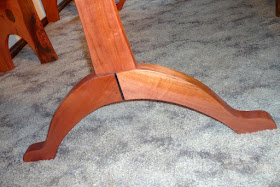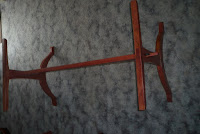As a gift for my wife for our fifth wedding anniversary I’ve been slowly working on a Shaker inspired dining table. Although it needs a final wax the table has already found its way into our home. (7 months after our anniversary…)
The table is made from Tasmanian Myrtle (supplied by Boutique Timbers) with Indian Ebony accents. The top is 1m x 2m. The central boards are of 20mm fiddleback the edging 40mm of the more straight grain. The top is stabilised with a two large breadboards and two braces beneath.
The feet are angled 40mm Myrtle joined together by a handcut sliding dovetail, and to the central post by a twin wedged tenon. The leg stretcher holds to the legs by a ebony keyed through tenon, allowing the legs to be removed and laid flat for transport.
The benches can cater for eight diners in comfort or ten on a squeeze. The 40mm timber is joined by halflap joint, screws and glue. Solid. The curved table legs allows foot room for people sitting on the ends and the central stretcher keeps well away from anyones knees. The is a single 10cm back support for the lumbar region. The sit depth is limited to 300mm (due to my planner width) which I wish her 400mm for more thigh support.
For more photos and detailed documentation of the work in progress check out old posts – the love of wood - Shaker Table #2: Tasmanian Mrytle.



















![View in fullscreen [Press F11] Fullscreen](http://btemplates.googlepages.com/fullscreen.gif)













